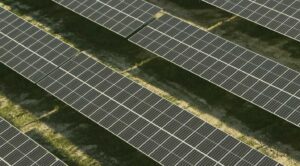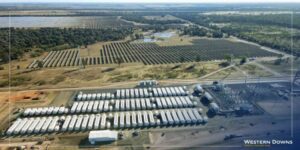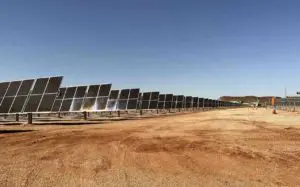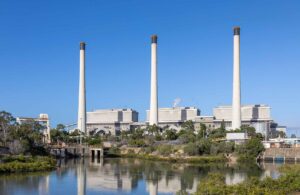There was a brief exchange on the ABC TV’s Q&A program on Monday night that neatly summed up all that is wrong with Australia’s energy policy.
Grahame Morris – a former chief of staff to Coalition prime minister John Howard, and a corporate lobbyist who is influential in the government of Tony Abbott – had, in the words of host Tony Jones, steam coming out of his ears at the idea that wind and solar could offer a future energy solution.
 Flapping his arms about and pointing his finger, Morris exclaimed: “Look, not everyone wants a bloody big windmill in their backyard … nuclear power is clean … one of the problems with the third world with poverty is that they don’t have electricity. We have coal and we have uranium that can provide energy sources for those people. You are talking about poverty … that is the answer.”
Flapping his arms about and pointing his finger, Morris exclaimed: “Look, not everyone wants a bloody big windmill in their backyard … nuclear power is clean … one of the problems with the third world with poverty is that they don’t have electricity. We have coal and we have uranium that can provide energy sources for those people. You are talking about poverty … that is the answer.”
Morris also scoffed at the idea of climate change and, with that, pretty much summed up the policy position of the Abbott government, its principal advisors, and the conservative think tanks that influence and applaud it.
It is a discourse – the belief in the primacy of centralised generation, be it coal or nuclear – that is guiding the Abbott government’s climate, energy and industrial policy. Disconcertingly, it is a view that spreads to the Labor Party, too, judging by the response of Labor’s Joel Fitzgibbon, from the Hunter Valley.
It’s also parroting the key marketing point of Big Coal: one that ridicules or downplays climate science, talks down the need to act, and places its faith in ageing technologies. The push against wind farms is a symptom of the view that nothing can or should change, and green policy can’t be allowed to be right about anything.
But it is plain wrong, and dangerously so. Later today, the global analyst firm Bloomberg New Energy Finance will release a new study and forecasts that are stunning in the speed and scale, and the flow of investment trillions, towards a new global energy system.
The BNEF report – see details on it here – predicts that households and business will account for more than half of Australia’s demand by 2040, and is the latest, and most comprehensive, of a series of reports that highlight the rapidly shifting sands of the global energy market, and the move from centralised generation to a decentralised future.
This has been canvassed by the likes of the CSIRO, the International Energy Agency, the biggest utilites, and global investment banks.
UBS last month came up with a report stating that a scenario where 50 per cent of all electricity generation was provided by solar by 2050 could not be ruled out. Much of this would be behind the meter, on the rooftops of homes and businesses.
Morgan Stanley has predicted 2.4 million homes in Australia will have battery storage. Even the owner of the Hazelwood coal-fired generator, one of Australia’s biggest and certainly its dirtiest coal plant, says half of all electricity consumption will be localised, rather than centralised within a few decades.
Remarkably, the Australian Energy Market Operator says that within 10 years, rooftop solar in South Australia will meet 100 per cent of demand on some days in the state. That leaves no room for baseload, centralised generation.
Last weekend I had a fascinating meeting with the head of smart grids for one of the world’s biggest engineering and power supply companies. The pace of development that he was talking about – and the investment dollars driving it – was quite stunning.
As one small example: A new housing development in NSW about to begin construction will be entirely off-grid. The economics are simple. Connecting a new housing division requires a developer to spend millions on grid infrastructure which it then has to “gift” back to the grid operator, and then its consumers pay rent for its use. Half of their bills will come from “networks costs”. It is energy as an indirect form of taxation.
But new technology and financial modeling means the network is not needed for such developments. The cost of solar PV and battery storage has now come down to the point where it is a “no brainer” to operate on a mini-grid. This is being recognised by international investment giants, with billions of dollars being invested. This housing development will be the first, but most will follow.
And it’s not just new housing projects. One town in Queensland is currently negotiating to go off-grid, and another dozen are contemplating the same thing. The same thing is happening in NSW.
The engineer says that households and business electricity use – and whole communities – will be almost entirely delivered by on-site or localised energy supply. He says that centralised generation can forget about the household and commercial markets. They will need to find large industrial consumers, and many of them will be seeking cleaner options than are currently on offer.
As Simon Richardson, the mayor of Byron shire, told a forum on the weekend, this push towards localised generation will be an irresistible and unstoppable force.
“Things are happening so fast in technology, what was considered pie in the sky just a few years ago is now considered to be legitimate and mainstream,” he said. Richardson had just returned from the climate talks in Bonn, where he was presenting Byron shire’s plan to be “zero net emissions” within 10 years.
In these scenarios, as Rob Stobbe, the head of SA Power Networks, has suggested, large centralised generators struggle to find a role. Any new development will be renewable, not fossil fuel, and they will be paired with storage. South Australia is currently looking to install the world’s largest utility-scale non-hydro storage scheme in the world.
Australia is likely to be a leader, notwithstanding the roadblocks erected by the Abbott government and state-owned and private utilities. It has the highest electricity prices, the cheapest solar prices, and the best conditions for the deployment of battery storage, without subsidies.
Yet Abbott, his advisors, their cronies, and those with vested interests and nuclear ideologies understand nothing of this. Like Morris, they believe that renewables are costly and ineffective. They dismiss “unreliables”, they see nuclear as the only replacement for coal.
The current push back against wind turbines, and the Abbott-endorsed witch-hunt, is just one example of this. In a hearing last week, an ANU professor James Prest is called “a prat”, and howled down by cross-bench and LNP Senators, when he dares point out the health impacts of coal-fired power stations.
Abbott’s campaign against wind has halted investment, will slow down future projects and put the brakes on the energy transition, making it more expensive than it need be.
His comment seems intent on encouraging, or investing, billions of dollars in investment in assets that are likely to be stranded by these new technologies. The reason why the market price for both thermal coal and uranium has plunged is that global demand is evaporating. The rest of the world has discovered new technologies and embraced them. Abbott is still trying to sell them the energy equivalent of a fax machine.
At least it has spawned some humour. Check out the video below for a funny take on Abbott’s wind farm policy.








